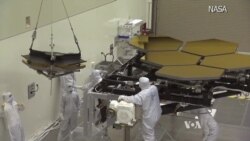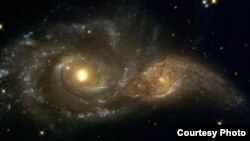While the space community is looking back this week to celebrate the 25th anniversary of the launch of the Hubble Space Telescope, workers in an airtight cleanroom at Goddard Space Flight Center in Greenbelt, Maryland, are looking ahead three years, to the launch of its successor, the James Webb Space Telescope.
The $8 billion Webb and the Hubble have a lot in common. Both operate in the vacuum of space, have mirrors that collect light from distant stars, use radio signals to transmit images and get power from the sun.
But the similarities end there, said Matt Greenhouse, a veteran project scientist for the James Webb Space Telescope.
“One of the biggest differences between the Webb and the Hubble is that the Webb is designed to be an infrared telescope and will see very primordial objects that are among the oldest objects in the universe,” he noted.
Greenhouse said the infrared capability will allow astronomers using the Webb to peer through the clouds and dust in space that obscure the view.
“With spectroscopy, which is spreading light out into component colors and observing one at a time, we can see features of individual atoms in molecules in space that will allow us to understand the chemistry that occurs in space. Many of those features only exist in the infrared,” he said.
Hubble can see a small segment of the infrared spectrum, but primarily captures visible and ultraviolet light.
Size matters
The Webb, named for the man who ran NASA from 1961-1968, will be sent 1.5 million kilometers above Earth's atmosphere, far beyond Hubble, which flies in low Earth orbit.
Its mirror is 6.25 times bigger than Hubble's, which will enable it to observe objects that are fainter and farther away. Made from lightweight beryllium and coated in gold for its reflective qualities, the segmented mirror was too large for the rocket that would carry it into orbit. So it had to be designed to unfold in space.
Its design also had to ensure that the instrument payload would be kept extremely cold, at approximately minus 200 degrees Celsius. Greenhouse explained,“The reason for that is because anything above absolute zero emits infrared light. If we didn’t cool it, it would be blinded by its own infrared emission.”
The Webb is shielded by a multi-layer sunscreen to keep light from the Sun and reflected light from the Earth and Moon from heating up the telescope and blocking any astronomical signal. For that to work, Greenhouse said, the Webb must be in an orbit with those three bodies lined up in about the same direction. “When it’s in that shadow under the sunscreen, it will cool naturally to this cryogenic temperature."
All those cutting-edge technologies combine to make the Webb 100 times more powerful than Hubble.
“We have some special capability in this instrument payload to observe as many as 100 galaxies at a time and obtain their spectrum simultaneously,” Greenhouse said proudly.
No second chances
As launch day approaches, Greenhouse said the assembly and testing now underway leave no room for error, like the mistake that sent Hubble into space with a flawed mirror.
“One of the big things we learned from the Hubble is the Hubble didn’t do something called an end-to-end optical test, where we take the entire observatory and shine light through it the way it will be done in space and make sure that everything works,” he said.
Unlike the Hubble, the Webb cannot be repaired in space, so the team has one chance to get it right.
Greenhouse, who has been with the Webb for almost the entire life of the project, expects the new telescope to rewrite textbooks much in the same way that Hubble has.
“Like Hubble, it’s likely that after this mission is over, we will look back and find that the most important discoveries and the most important questions that were answered are not the questions that we had in mind when we designed and built it,” he said.
The Hubble has operated much longer than expected, and Greenhouse said he hopes for the same lifespan for the Webb, which could last 10 years or longer.
The James Webb Space Telescope is a project of the U.S., European and Canadian space agencies.










